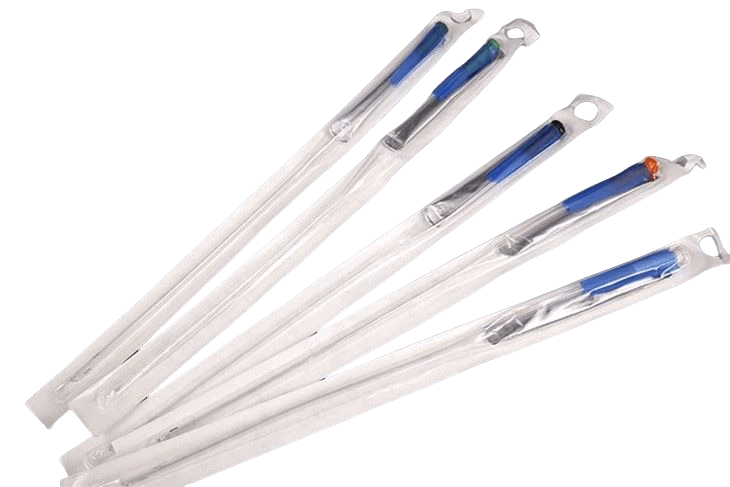TEl: +86-13148388090
Fax:+86-571-88616515
A Comprehensive Guide to Catheter Use in Clinical and Home Care Settings
Author: admin / 2025-08-01Nursing Tools, Protocols, and Practical Tips for Better Catheter Care.

Introduction
Urinary catheters are essential medical devices used to assist patients who are unable to urinate naturally. They are widely applied in hospitals, long-term care institutions, and increasingly within home care environments.
Whether managing urinary retention, supporting post-surgical recovery, or aiding individuals with reduced mobility or neurological impairments, catheters play a vital role in maintaining patient comfort and dignity. This guide is intended for healthcare professionals, caregivers, and family members involved in catheter care, offering clear information and practical guidance for safe and effective use.
Types of Urinary Catheters
Indwelling (Foley) Catheters:These are inserted into the bladder via the urethra and secured by an inflatable balloon. They are commonly used for post-surgical patients, those who are unconscious, or individuals with serious mobility limitations.
Intermittent Catheters:Designed for temporary use, these are inserted multiple times a day to empty the bladder and removed after each use. They are suitable for home use and for patients performing self-catheterization.
External Catheters:Often referred to as condom catheters, these are worn externally by male patients and connected to a drainage bag. They are non-invasive and typically used for managing incontinence in male patients.
Coude Catheters:Featuring a slightly curved tip, coude catheters are designed to bypass obstructions such as an enlarged prostate. They are commonly prescribed for male patients with urethral strictures or benign prostatic hyperplasia (BPH).
Male vs. Female Catheters:Catheters for men are generally longer (approximately 16 inches) to accommodate the male anatomy. Female catheters are shorter, usually between 6 to 8 inches, reflecting anatomical differences.
Hospital Catheter Use
Clinical Applications
Catheters are routinely used in clinical settings for:
- Post-operative bladder management
- Acute or chronic urinary retention
- Neurological impairments affecting bladder control
- Long-term immobilized patients
Sterile Insertion Protocols
Strict adherence to aseptic technique is critical. Best practices include:
- Hand hygiene before and after insertion
- Use of sterile gloves and equipment
- Application of antiseptic solution
- Selecting the smallest effective catheter size
Nursing Tools and Protocols
- Pre-packaged catheterization kits
- Securement devices to prevent displacement
- Closed drainage systems
- Routine documentation and patient monitoring
Preventing CAUTI (Catheter-Associated Urinary Tract Infections)
- Limit use to clinically necessary cases
- Remove the catheter as early as possible
- Maintain a sealed, properly positioned drainage system
Home Catheter Care
Common Catheter Types for Home Use
Home settings primarily use intermittent or pre-lubricated catheters for ease of handling and reduced infection risk. Patients or caregivers must be trained in proper insertion and maintenance techniques.
Training for Family and Caregivers
- Provide clear, step-by-step instructions
- Reinforce hand hygiene and safe handling practices
- Teach how to recognize early signs of complications
Daily Care Essentials
- Always wash hands before and after handling
- Gently clean the insertion area with mild soap and water
- Change drainage bags as needed
- Inspect for discomfort, discharge, or signs of infection
Maintaining Dignity and Hygiene
A clean, organized environment helps prevent infection and supports the emotional well-being of patients. Privacy and respect should always be maintained during catheter-related care.
Best Practices for Catheter Maintenance
- Keep the drainage system closed and secured
- Avoid unnecessary movement or tugging of the catheter
- Change the urine bag regularly
- Observe urine for any changes in color, odor, or clarity
- Maintain a care log to track routine and unusual events
Special Considerations for Coude Catheters
When to Use
- Men with enlarged prostates
- Patients with urethral scarring or strictures
Insertion Guidelines
- Align the curved tip toward the patient's navel
- Use adequate lubrication
- Advance the catheter gently; stop if resistance or severe discomfort occurs
Warning Signs
- Blood in the urine
- Sharp or persistent pain during insertion
- No urine flow after catheter placement
Preventing Complications and Infections
Common Risks
- Urinary tract infections
- Catheter blockages
- Bladder spasms
Signs Requiring Attention
- Fever, chills, or lower abdominal discomfort
- Foul-smelling, cloudy, or discolored urine
- Reduced or absent urine output
Use of Antimicrobial Catheters
These catheters, coated with antibacterial agents, may help reduce infection risk in high-risk individuals. However, they are not universally necessary and should be selected based on clinical need.
When to Contact a Healthcare Provider
- Catheter stops draining
- Significant leakage or displacement
- Visible blood or unusual pain
Conclusion
Catheters are more than just medical devices—they are integral to preserving health, dignity, and comfort for many patients. Whether in a hospital or home setting, proper catheter care can significantly reduce complications and improve outcomes.
By using evidence-based protocols, maintaining hygiene, and choosing the right catheter types—such as hydrophilic or pre-lubricated models—caregivers and clinicians can ensure safe, efficient, and respectful management of urinary needs.
BEVER Medical hydrophilic catheters for easy insertion, less friction, and lower infection risk. Pre-lubricated and ready to use—they're a smart choice for comfort and care.


